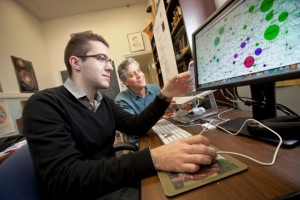In the world of Facebook and Twitter, rumors fly quickly. Gary Gordon, professor and associate head of mathematics, and Dorde Rakic ’15 (Belgrade, Serbia) are delving into social media to learn how rumors affect people and influence their behavior.

Dorde Rakic ’15 and Professor Gary Gordon look over a matrix of information.
“Think of people on Facebook, with two people connected if they are friends. How quickly does a rumor spread?” says Gordon. “If a certain influential group of people prefer some product, say Coke to Pepsi, can they influence the behavior of a large group of ‘friends?’ These are the kinds of problems we looked at, and we have several different models for how this kind of influence spreads in a network.”
Gordon and Rakic hope to develop a good model that can easily be implemented and have real-world applications.
“This research is at the intersection of applied mathematics and computer science,” says Gordon. “This is important for people in marketing, but has applications to lots of other areas, like the spread of disease in epidemiology. For instance, during the recent flu epidemic, it is possible to use this theory to find groups of students who exhibit symptoms earlier than the general population. Identifying this group early has obvious advantages for treatment and prediction of how quickly the disease will spread.”
The pair started work on the project after Rakic approached Gordon with the research idea. While the research is related to Gordon’s previous work in network theory and reliability theory, this project went in a new direction.
“I got the idea of looking at people as being connected in a big network such as Facebook, or any other social network, and trying to spread something, such as a rumor, virus, idea, etc.,” says Rakic, a double major in mathematics and computer science. “Professor Gordon was very interested in this project, so together we developed different models for spreading, and made a couple of simulations that we found over the time.”
After researching the progress of others trying to solve similar problems, Gordon and Rakic decided on a plan of action. Rakic has spent time writing computer codes, applying them to real networks, and simulating various outbreaks in sample networks.
“The collaboration between students and faculty is important, and helps both the student, who gets to see what academic research is like, and the faculty member, who gets an excited, bright, motivated student with energy and ideas,” says Gordon.
Rakic is excited that their work deals with a real-life problem and is something he can apply whether he pursues a career in math or computer science.
“The results actually reveal something connected with our world and the fact that I can use both of my majors to work on this project and get some results just thrills me,” he says. “In the future, I hope to be somewhere where I will be facing new and fun problems each day that will require a lot of thinking and teamwork. This project has taught me the importance of teamwork and the need to appreciate different points of view and opinions.”
Rakic’s research was funded in part through the EXCEL Scholars undergraduate research program. EXCEL students earn a stipend while working one-on-one or in small groups with faculty. Many projects result in conference presentations and publication in peer-reviewed journals.
